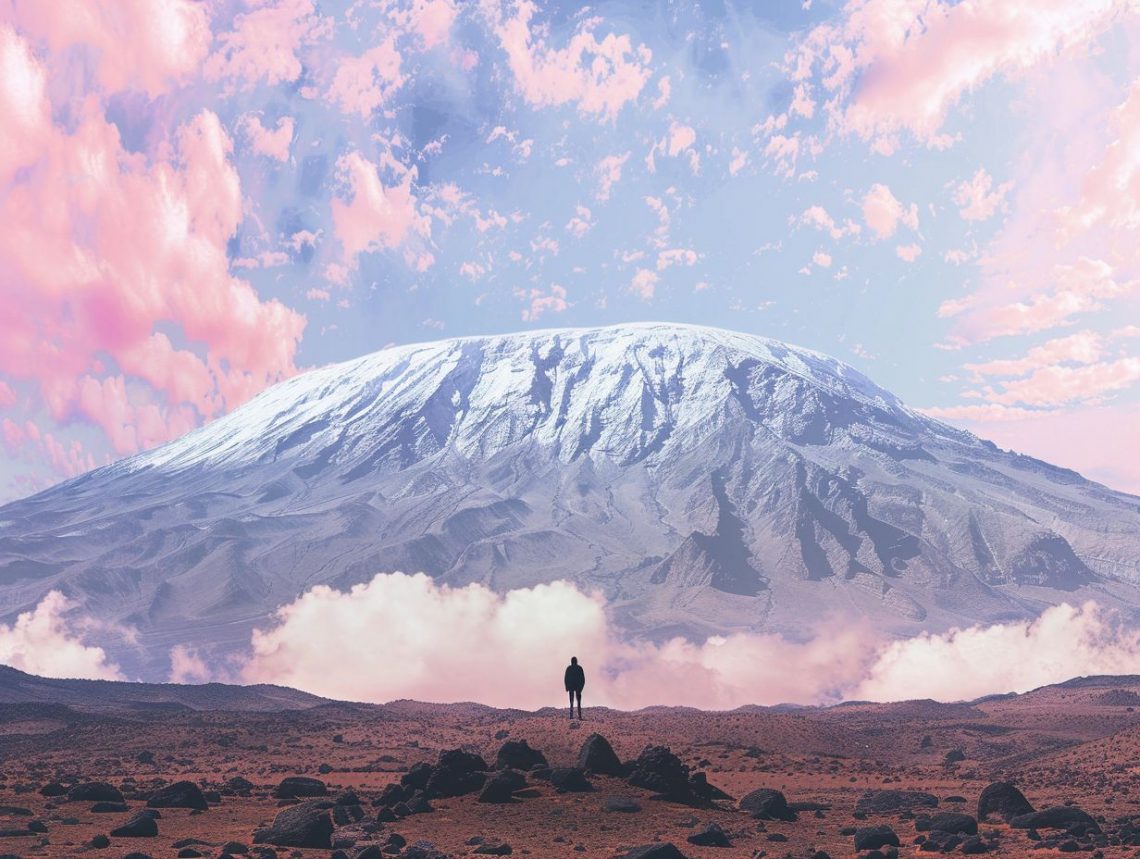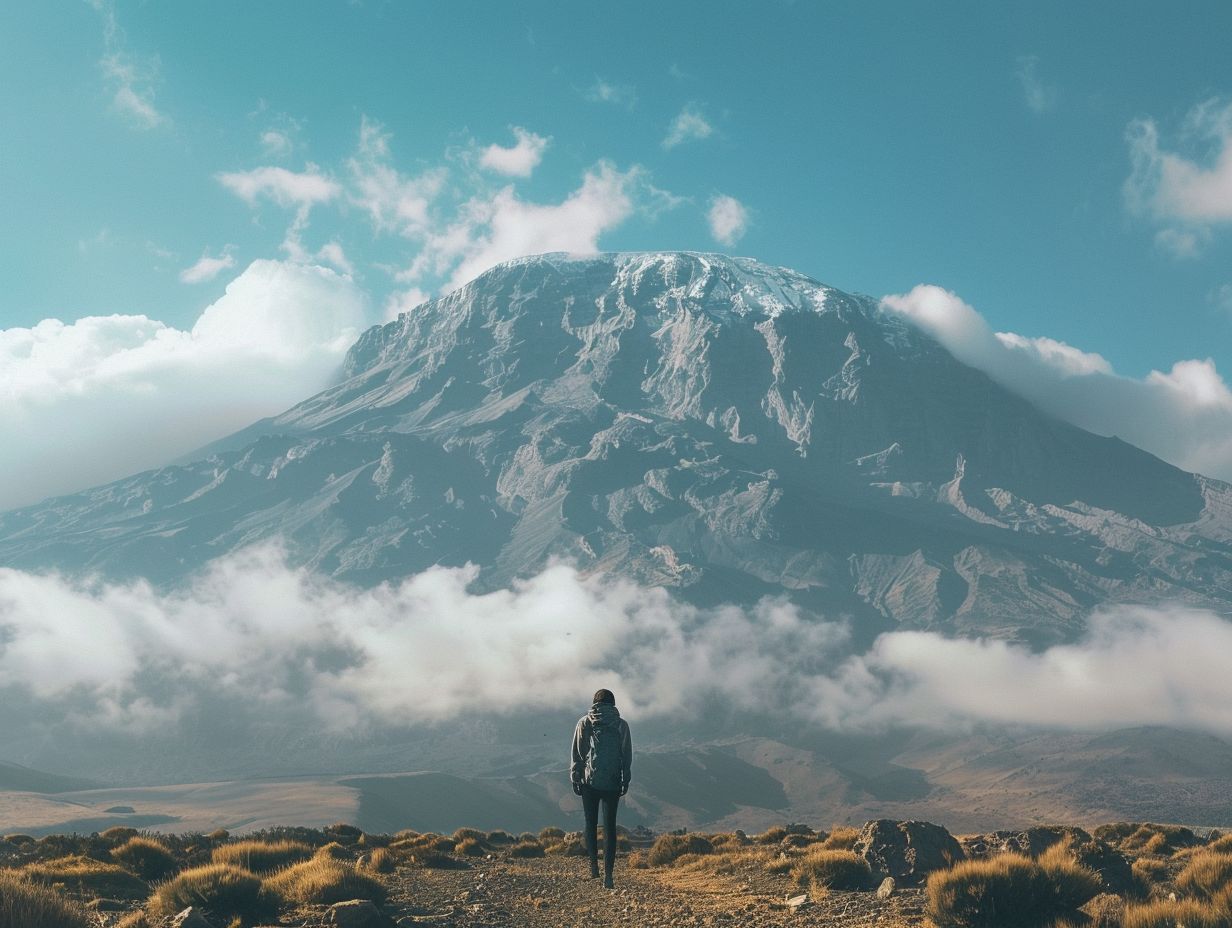
Can A Normal Person Climb Kilimanjaro
Have you ever wondered if a normal person like yourself could climb Kilimanjaro, the highest mountain in Africa?
This article will provide you with all the essential information you need to know before embarking on this incredible adventure.
From the location and elevation of Kilimanjaro to the physical requirements and challenges you may face, we will cover everything you need to prepare for this once-in-a-lifetime experience.
So, lace up your hiking boots and get ready to conquer the mighty Kilimanjaro!
Key Takeaways:

- Climbing Kilimanjaro is physically demanding and requires proper preparation and gear.
- Altitude sickness and extreme weather conditions are the main challenges of climbing Kilimanjaro.
- With proper training, acclimatization strategies, and determination, a normal person can successfully reach the summit of Kilimanjaro.
What is the Elevation of Kilimanjaro?
Kilimanjaro’s summit, known as Uhuru Peak, reaches an impressive altitude of 5,895 meters (19,341 feet) above sea level, making it the highest point in Africa.
Standing at the awe-inspiring Uhuru Peak not only offers breathtaking panoramic views of the vast East African landscape but also provides climbers with a profound sense of accomplishment.
At this unparalleled height, the air thins, and every step is a testament to sheer determination and resilience. The journey to the summit is a mental and emotional challenge that pushes individuals to their limits, both physically and mentally.
What is the Difficulty Level of Climbing Kilimanjaro?
Climbing Kilimanjaro presents a formidable challenge both physically and mentally, testing the endurance and resilience of adventurers.
The journey to the summit is filled with various physical challenges such as altitude sickness, extreme weather conditions, and strenuous terrain that put significant strain on the body.
Climbers must acclimatize to the high altitude, where the air is thinner, causing fatigue and breathlessness. This demanding environment requires mental strength to push through moments of doubt and exhaustion.
The sense of accomplishment and breathtaking views from the summit make conquering Kilimanjaro a truly rewarding experience.
What are the Requirements for Climbing Kilimanjaro?
Climbing Kilimanjaro requires a combination of physical fitness, proper gear, and effective acclimatization strategies. Preparation is key to ensuring a successful and safe ascent of this iconic mountain.
1. Physical Fitness

Physical fitness is crucial for tackling the challenges of climbing Kilimanjaro. Endurance, stamina, and strength are essential to endure the demanding trek to the summit and back.
Training plays a pivotal role in preparing climbers for the rigorous journey ahead. Developing cardiovascular fitness and muscle strength through targeted exercises is vital.
The physical demands of Kilimanjaro necessitate a well-rounded training regimen that includes cardio, strength training, flexibility, and altitude acclimatization.
Without adequate preparation, climbers risk exhaustion, altitude sickness, and failure to reach the summit. Thus, the challenge of Kilimanjaro demands commitment to physical fitness and rigorous training.”
2. Proper Gear and Clothing
Having the right gear and clothing is essential for a successful Kilimanjaro climb. Proper equipment, including suitable footwear, clothing for varying weather conditions, and ample hydration supplies, is crucial for the journey.
Appropriate footwear is vital to protect your feet during the trek. Go for sturdy hiking boots with ankle support to navigate the rugged terrain comfortably.
Layering clothing is key to adapting to the diverse weather on the mountain; pack moisture-wicking base layers, insulating mid-layers, and waterproof outer shells.
Along with this, investing in quality gloves, hats, and sunglasses can shield you from harsh sun exposure and freezing temperatures.
Staying hydrated is paramount at high altitudes to prevent altitude sickness. Carry a reliable water bottle or hydration system to ensure you drink enough water throughout the expedition.
Don’t underestimate the significance of a good backpack to carry your essentials, like snacks, extra layers, and first aid supplies.
3. Acclimatization
Acclimatization is key when climbing Kilimanjaro to prevent altitude sickness and ensure a safe ascent. Allowing the body to adjust to the increasing altitude and lower oxygen levels is vital for a successful trek.
Altitude sickness, also known as acute mountain sickness (AMS), can occur when ascending too quickly without giving the body enough time to adjust to the reduced oxygen levels at higher altitudes.
Symptoms of AMS can range from mild headaches and fatigue to more severe conditions, such as pulmonary or cerebral edema.
Therefore, climbers must follow proven strategies like gradual ascent, hydration, proper nutrition, and adequate rest to acclimatize effectively. Taking it slow, staying hydrated, and listening to your body are crucial practices to ensure a safe and enjoyable climb.
How Long Does it Take to Climb Kilimanjaro?
The duration of a Kilimanjaro climb varies depending on the route chosen and individual fitness levels. Climbs can range from 5 to 9 days, with each route offering unique challenges and experiences.
Different Routes and Timeframes
Kilimanjaro offers various routes with different durations and camping options. The choice of route impacts the number of nights spent on the mountain and the overall experience of the climb.
Each route on Kilimanjaro presents its own unique challenges and picturesque landscapes. For example:
- The Machame route is known for its stunning scenery and varied terrain
- The Marangu route, also known as the ‘Coca-Cola’ route due to its more gradual incline, offers hut accommodations instead of camping.
- The Lemosho route is perfect for those seeking a more remote experience with fewer crowds,
- and the Rongai route provides a more gradual ascent from the north side of the mountain.
Regardless of the route chosen, trekkers will have the chance to explore the diverse ecosystems found on Africa’s highest peak.
What is the Best Time of Year to Climb Kilimanjaro?
Choosing the best time of year to climb Kilimanjaro is crucial for a successful trek. Understanding the weather conditions and seasonal variations can help climbers plan their expedition for optimal conditions.
Regarding deciding the ideal season for taking on the challenge of Kilimanjaro, it’s essential to consider the distinct weather patterns that each season brings.
For instance, the dry season, which falls between June to October, is generally regarded as the best time for climbing due to clear skies and less precipitation.
The rainy season (March to May) brings muddy trails and poor visibility, while the colder winter months (December to February) pose challenges at higher altitudes.
Considering these climatic conditions is crucial for climbers as they navigate the varying terrains and altitudes along the trek, ensuring safety and an enjoyable experience.
What are the Challenges of Climbing Kilimanjaro?

Climbing Kilimanjaro presents various challenges, including altitude sickness and unpredictable weather conditions. Overcoming these obstacles requires preparation, resilience, and adaptability.
1. Altitude Sickness
Altitude sickness is a common challenge faced by climbers on Kilimanjaro due to the rapid ascent and high altitude. Symptoms include headaches, nausea, and fatigue, emphasizing the need for proper hydration and acclimatization.
Acclimatization, the process of the body adjusting to higher altitudes, is key in preventing altitude sickness. Climbers are advised to ascend slowly, allowing their bodies time to acclimatize properly.
Proper rest and nutrition play vital roles in preparing the body for the challenges of high altitude.
Staying hydrated, ascending gradually and listening to your body are essential components for a successful Kilimanjaro climb and minimizing the risk of altitude sickness.
2. Weather Conditions
Weather conditions on Kilimanjaro can be unpredictable and harsh, ranging from scorching heat to freezing cold. Climbers must be prepared for varying temperatures and weather patterns throughout their ascent.
During the day, the sun can beat down intensely, making hydration and sun protection essential.
As night falls, temperatures can plummet, requiring climbers to have appropriate cold weather gear to combat the extreme cold.
The mountain’s high altitude also contributes to these temperature variations, making it crucial for climbers to layer their clothing accordingly to stay warm and comfortable.
How to Prepare for Climbing Kilimanjaro?
Effective preparation is essential for climbing Kilimanjaro, encompassing training, acclimatization, and mental readiness.
1. Training and Exercise
Training and exercise play a vital role in preparing for a Kilimanjaro climb. Building endurance, strength, and cardiovascular fitness are essential to tackle the physical demands of the expedition.
Given the challenging terrain and high altitude of Mount Kilimanjaro, climbers must be in top physical condition to endure long hours of trekking and extreme weather conditions.
Fitness levels need to be at their peak to minimize the risk of altitude sickness and ensure a successful ascent. Therefore, incorporating a variety of activities such as hiking, running, and strength training into one’s regimen is crucial.
2. Acclimatization Strategies
Taking rest breaks, staying hydrated, and ascending gradually are key elements of successful acclimatization.
Climbers ascending Kilimanjaro should make sure to maintain adequate oxygen intake by breathing deeply and slowly, allowing their bodies to adjust to the altitude.
It is essential for climbers to schedule regular breaks to give their bodies time to acclimate and recover.
Hydration plays a major role in the acclimatization process, with climbers advised to drink plenty of water to combat the effects of high altitude.
It is recommended to follow a staggered ascent plan to gradually adjust to the changing altitudes, minimizing the risk of altitude sickness.
Conclusion

While climbing Kilimanjaro is a significant physical and mental challenge, with proper preparation, guidance, and determination, even a ‘normal’ individual can achieve the remarkable feat of reaching the summit.
Success on Kilimanjaro is not solely measured by reaching the summit but also by the journey taken to get there. The sense of accomplishment at the top is unmatched, knowing the obstacles overcome and the heights attained.
Embracing this challenge not only tests one’s endurance and resilience but also fosters personal growth and self-belief. It’s a powerful experience that transcends the physical aspects of the climb.
Therefore, while climbing Kilimanjaro may seem daunting, the rewards, both physical and emotional, make it a worthwhile pursuit for those seeking success and self-discovery.
Frequently Asked Questions
1. Can a normal person climb Kilimanjaro?
A: Yes, a normal person can climb Kilimanjaro with proper preparation and training.
2. What does it mean to be a “normal” person in terms of climbing Kilimanjaro?
A: A “normal” person refers to someone who does not have any physical limitations or disabilities that would prevent them from climbing Kilimanjaro.
3. Do I need any special skills or experience to climb Kilimanjaro?
A: While prior hiking experience and physical fitness can be beneficial, they are not necessary for a successful climb. Anyone with determination and a positive attitude can climb Kilimanjaro.
4. Are there any age restrictions for climbing Kilimanjaro?
A: There are no strict age restrictions, but it is recommended that climbers be at least 12 years old. Climbers under the age of 18 must be accompanied by a parent or legal guardian.
5. What is the success rate for normal people climbing Kilimanjaro?
A: The overall success rate for climbing Kilimanjaro is around 65%, but it varies depending on factors such as route, weather, and individual fitness levels.
6. How can I prepare myself to climb Kilimanjaro as a normal person?
A: It is recommended to start a regular exercise routine at least 6-8 weeks before your climb to improve your fitness level. You should also consult with a doctor before attempting to climb Kilimanjaro.